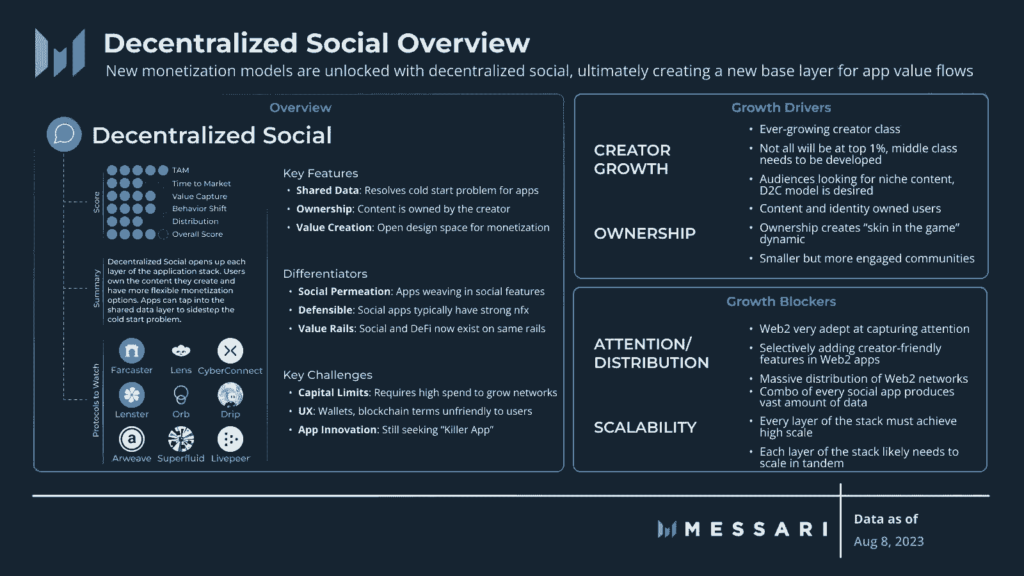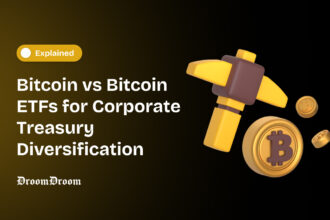SocialFi, a trailblazer of Social Finance, is Web3’s answer to Web2’s social media platforms by restoring ownership to users and content creators, directly offering more lucrative monetization possibilities by removing expensive intermediaries. This natural evolution of DeFi and social media champions the hallmark values of decentralization such as privacy, security, censorship, and data ownership, promoting a fairer form of monetization where creators keep the lion’s share of the value they produce.
SocialFi innovations are marking a departure from conventional social networking paradigms by introducing a decentralized, self-governed and community-driven environment for users to interact with each other, share content and earn rewards. SocialFi innovations are opening up new opportunities for businesses and entrepreneurs along with decentralized collaboration spaces that reward users for their contributions and allow them to monetize their content while keeping more of their earnings.
According to dAppRadar’s 2023 Dapp Industry Report, there has been an impressive increase in the social sector in 2023 with the daily count of Unique Active Wallets (UAW) exceeding 250,000. Compared to 2022, there was a substantial growth of 518%, which underlines the importance of decentralized social media.
In this article, we will explore some of the most exciting SocialFi innovations that are driving the growth and adoption of this space.
Quick Overview of How SocialFi Functions
Unlike traditional social media platforms controlled by massive centralized parties, SocialFi uses Decentralized Autonomous Organizations (DAOs) to make decisions–ensuring no single entity controls the platform while maintaining users’ say in how it operates. With the help of DAOs, developers and the platform’s team are prevented from making unilateral changes to the code fostering trust and transparency.
The economy within these SocialFi innovations is fueled by decentralized tokens tokens used for various purposes like tipping creators or participating in governance voting to determine the direction in which the platform evolves.
On some of these platforms, creators can even launch their own tokens to directly monetize their influence and content.
How?
Since users control their wallets and tokens, they can choose which creators to engage with and want to support by holding the creator’s token to participate.
Digital ownership is facilitated through features like a profile picture (PFP) NFTs for identity and other NFTs to track content ownership, allowing for the monetization of content, including posts, videos, and more.
Decentralized SocialFi models allow for incentivized engagement and affiliate programs, with users controlling their wallets and tokens, choosing which creators to support by holding the creator’s token.
SocialFi Innovations: A Look at Emerging Trends
Messari’s Crypto Theses 2024 Report discusses socialFi innovations as part of the three new “De’s” of decentralized innovations, including DeSoc which is short for Decentralized Social Media. DeSoc relieves creator woes of traditional social platforms that take a hefty cut from revenue generated through advertising or sponsored content.
Moreover, with SocialFi platforms like SuperDapp, content remains unalterable, ensuring users can share information without fear of being censored.

Clearly, it is a rapidly evolving field with new socialFi innovations and use cases on the brink of it. Here, we explore some of the most interesting innovations that are pushing the boundaries of what’s possible.
Combating Fake Content & Fraud
Many SocialFi platforms grapple with the challenge of fraudulent activity aimed at manipulating reward systems. The research paper titled, “Blockchain-based Reputation Evaluation Using Game Theory in Social Networking”, proposes a novel approach for evaluating reputation on social media platforms that leverages blockchain technology and game theory to tackle the issue of ‘ghost commentators’.
SocialFi innovations include developing advanced anti-fraud algorithms to detect and prevent such behavior. These algorithms can analyze user engagement patterns and identify suspicious activity that might indicate attempts to inflate rewards through inauthentic means such as bots.
The AI-infused SocialFi platform SuperDapp prioritizes security by offering features like encrypted communication and secure storage. Additionally, AiDA, SuperDapp’s AI assistant has the potential to further enhance users’ experiences by filtering out abusive or spammy behavior.
“At the heart of our innovative pursuit, we recognize that the true strength of blockchain lies not just in securing transactions but in building trust and transparency across digital communities. By integrating artificial intelligence, we are setting new standards for integrity and user experience in the SocialFi ecosystem.”
Jagdeep Sidhu, SYS Labs CEO
Decentralized Social Graphs and Interoperability
A core tenet of SocialFi is the concept of user ownership and control over data.
Decentralized social graph protocols are merging to address this need and they’ve become existential for free and open speech as highlighted by The necessity of this has also been reflected in mainstream Web2 platforms, particularly demonstrated by Elon Musk’s Twitter acquisition and the potential for “coordinated advertiser boycotts.
On the Web3 side, these protocols leverage blockchain technology to store user data, such as profiles, posts and follower lists. Ultimately, users can control who can access their information, providing them with the freedom to move their social graph– their network of connections–across different SocialFi applications built on compatible protocols.
Account abstraction is another innovation facilitating interoperability across blockchains by simplifying the onboarding process for new users by eliminating the need to manage multiple private keys for different chains. This reduces the barrier to entry for users unfamiliar with the complexities of blockchain technology.
Features like portable social graphs are moving beyond being exceptional perks, and quickly becoming the standard a more informed generation of users have come to expect.
Rebalancing Power and Profits
Traditional social media platforms often generate substantial revenue from user data while users themselves see little to no financial benefit from their contributions. This is because legacy, centralized platforms have relied on the well established norm of, “If you are not paying for the product, then are the product.”
A cursory look at the market cap of major social media company’s market caps will show just how valuable that data, which users have given freely, has turned out to be. By enshrining each user’s right to ownership and privacy, SocialFi requires an entirely different model to both incentivize user participation and ensure its own sustainability.
This necessity is fulfilled by utility tokens, or “cryptocurrencies with actual purpose”, the purpose in this instance being the lifeblood of a self-sustaining ecosystem or economy.
In the case of SuperDapp, its economy is supported by its utility token, SUPR. Aside from being a simple payment method, SUPR also supports widely used DeFi applications such as staking, or locking the token as collateral in order to contribute to the platform’s liquidity and economic stability, earning rewards in the process.
This is similar to how a savings account at an old-fashioned bank works, even including an APR (annual percentage rate) and APY (annual percentage yield) that automatically adjusts so potential stakers can always make an informed decision.
Aside from payments and staking, as previously mentioned, SUPR ownership also entitles users to directly participate in SuperDapp’s governance by voting on policies and features they believe are in the best interest of the platform.
Watch-to-Earn and Fan Engagement
A growing trend in SocialFi is the concept of Watch-to-Earn wherein the platforms reward users with crypto tokens for actively engaging with content such as watching videos or interacting with creators.
Brave Browser, and its token, BAT, is a Web3 pioneer of this basic concept. BAT stands for “Basic Attention Token”, aptly named for a token intended to attach a monetary value to how internet users spend their time or to what they give their attention.
Some Watch-to-Earn platforms allow creators to issue their own tokens, which fans can earn by engaging with the creator. These creator tokens can offer various benefits such as governance rights over the creator’s content or access to exclusive perks as determined by their issuer, the creator.
In order to avoid a proliferation of meaningless tokens, think of them as “sub-tokens” to SUPR. The total value of a sub-tokens’ supply can only be as valuable as the amount of SUPR that has been locked to mint them.
So what happens if a creator whose token you hold has done something you dislike and you no longer wish to support them? It’s simple, once the lock period of the SUPR you exchanged for the creator’s token expires, cash out and switch back to SUPR.
If the creator offended more than just you, causing their popularity to decrease, then you’ll get less SUPR in return. Vice versa, if the creator has grown in popularity and support, then you’ll receive more SUPR back than you initially put in.

Empowering the Future: The Impact of SocialFi
SocialFi represents a transformative shift from the centralized, profit-driven models of traditional social media to a decentralized, user-centric ecosystem. By placing ownership and control back into the hands of users, SocialFi platforms like SuperDapp are not just challenging the status quo – they are paving the way for a more equitable and engaging digital future.
The innovations driving SocialFi—from combating fake content and fraud to fostering interoperable social graphs and rewarding active participation—are laying the foundation for this new paradigm. These advancements ensure that users can interact in a secure, transparent, and rewarding environment, free from the constraints and exploitative practices of legacy systems.
Platforms like SuperDapp exemplify the potential of SocialFi innovations with its comprehensive suite of features, including AI-powered moderation, decentralized governance, community-building features like Super Groups and incentivized engagement through mechanisms like Watch-to-Earn and creator tokens.
By integrating these cutting-edge technologies, SuperDapp is not just enhancing user experience but also building a thriving community where users can truly benefit from their contributions.
As we look to the future, SocialFi innovations stand at the forefront of digital innovation, offering a glimpse into a world where online interaction is not only more secure and private but also more rewarding and community-driven. The journey of SocialFi innovations has only just begun, and with platforms like SuperDapp leading the way, the possibilities for growth and positive change are boundless.




















